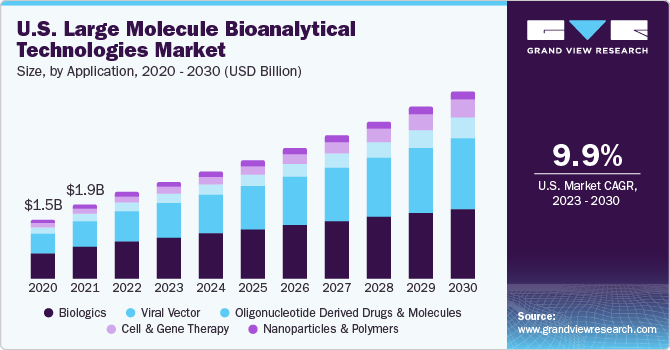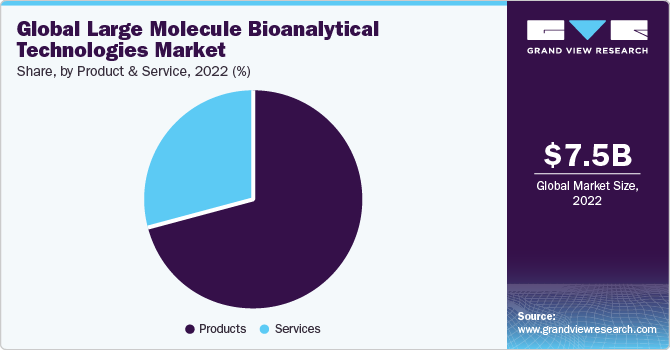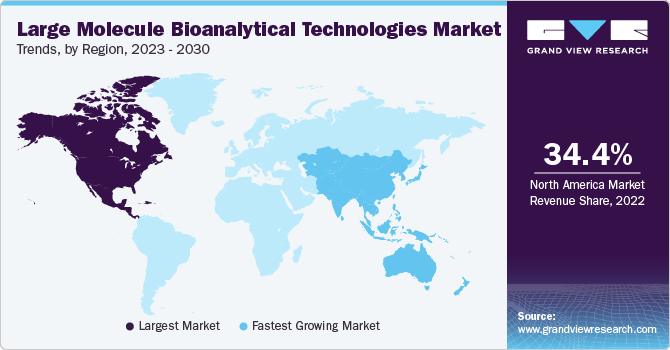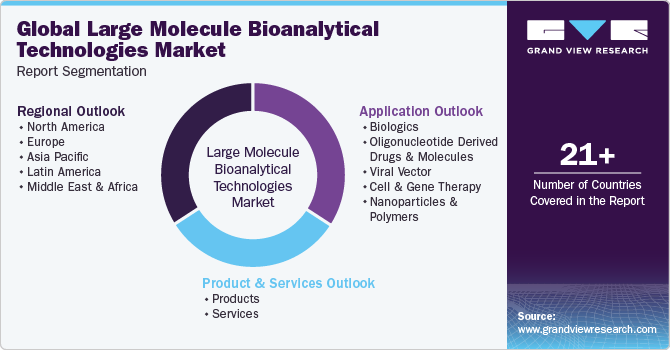- Home
- »
- Biotechnology
- »
-
Large Molecule Bioanalytical Technologies Market Report, 2030GVR Report cover
![Large Molecule Bioanalytical Technologies Market Size, Share & Trends Report]()
Large Molecule Bioanalytical Technologies Market Size, Share & Trends Analysis Report By Products & Services, By Application (Biologics, Cell & Gene Therapy), By Region, And Segment Forecasts, 2023 - 2030
- Report ID: GVR-4-68039-425-9
- Number of Report Pages: 258
- Format: PDF, Horizon Databook
- Historical Range: 2018 - 2021
- Forecast Period: 2023 - 2030
- Industry: Healthcare
Market Size & Trends
The global large molecule bioanalytical technologies market size was valued at USD 7.47 billion in 2022 and is expected to grow at a compound annual growth rate (CAGR) of 10.5% from 2023 to 2030. Along with the ongoing shift toward R&D programs for large molecules, there is an increasing diversity in the type of therapeutics modalities being tested analytically. This ongoing trend toward a greater diversity demands a wider set of expertise to assess the quality attributes of the final products, thereby driving the market for large molecule bioanalytical technologies. Furthermore, the COVID-19 pandemic has created lucrative opportunities for key stakeholders in this space. Several CMOs and bio-manufacturers have shifted their business focus to producing therapeutics against SARS-CoV-2 infection. Thus, the demand for bioanalytical testing tools has grown significantly.

Several initiatives, such as scaling up of production and testing facilities by key players, have propelled revenue generation. The introduction of Quality by Design (QbD) and its growing acceptance in the field fuel the necessity for more robust analysis methods. Currently, QbD has significantly impacted the work performed in analytical laboratories. Another trend is the identification of measures to expedite the manufacturing process. The improving efficiency in formulation development aspects has alleviated the timelines associated with challenges for analytical processes.
Furthermore, regulatory pressures are vital in driving a more detailed analysis of final products. These new innovative drugs require thorough biocompatibility, toxicology, and chemical characterization to maintain the efficacy and safety of the products for human consumption. The convergence of biochemical testing with the digital age offers several opportunities and poses challenges for analytical testing laboratories.
The deployment of handheld devices for collecting and transmitting analytical data is being studied to advance the market for large molecule bioanalytical technologies. Furthermore, the market is anticipated to be positively impacted with the introduction of real-time analysis of clinical samples and in-process manufacturing samples. Moreover, advancements in instrumentation are also anticipated to expand the reach of the market and would continue to enhance offerings by service providers.
Products & Services Insights
The product segment dominated the market for large molecule bioanalytical technologies and accounted for a revenue share of 71.4% in 2022. Key contributors to this segment's dominance include new product launches, technological advancements, and growing adoption by QC labs, CROs, and pharmaceutical companies. The segment is further classified into instruments, reagents & kits, and consumables & accessories.
The presence of a wide array of instruments for biopharmaceutical applications, such as for identification of impurities, determination of protein content, and measurement of stability, has led to high revenue generation by the instruments sub-segment. In addition, key players operating in the large molecule bioanalytical technologies industry are launching new instruments for supporting the development of bio-therapeutics.

The service segment, on the other hand, is anticipated to expand at the fastest CAGR of 11.1% during the forecast period. The primary factor that can be attributed to the anticipated segment growth is the increasing rate of collaboration of drug manufacturers with companies that are offering analytical testing services. In addition, the stringent regulatory framework for the use of vectors, reagents, and excipients is driving segment expansion.
Application Insights
The biologics segment dominated the market for large molecule bioanalytical technologies with a revenue share of 42.7% in 2022. The biologics segment represents the major class of modern therapeutics, and its share is constantly increasing as compared to small molecule drugs. Monoclonal antibodies and vaccines have gained significant traction in the past few years.
During the COVID-19 pandemic, the vaccine segment witnessed rapid growth. Extensive efforts for the research & development of a safe and effective vaccine led to a rapid increase in demand for vaccine stability testing. However, there is a continuous demand for analytical testing services for quality assurance, as several vaccines for other life-threatening diseases have been developed or are in development.
Furthermore, owing to the rising adoption of advanced therapies, the regulatory landscape is constantly evolving, including requirements regarding chemistry, manufacturing, and control (CMC) information. Thus, several companies have shifted their focus on offering a wide range of services for the characterization and quality testing of cell and gene therapy-based products, accelerating segment growth.
Regional Insights
North America accounted for the largest revenue share of 34.4% in the market in 2022. The presence of large-scale biopharmaceutical manufacturing facilities and expanding biopharmaceutical R&D in the U.S. have majorly contributed to the region's dominance. Furthermore, a stringent regulatory framework for biologics has increased the significance of bioanalytical testing. The U.S. biopharmaceutical industry is a major global contributor to new drugs, accounting for around 57.0% of all such offerings. Thus, the demand for analytical testing is continuously high in the U.S., leading to significant revenue generation.

The Asia Pacific region is projected to witness the fastest CAGR of 12.3% through the forecast period. Several CROs are expanding their footprints in Asian countries, with China at the forefront. For instance, in October 2020, PPD Inc., a leading global CRO based in the U.S., announced the imminent opening of a new clinical research laboratory in Suzhou, China. Equipped with a wide range of instruments, this lab offers services in the areas of biologics, cell & gene therapies, and small molecules.
Key Companies & Market Share Insights
The market for large molecule bioanalytical technologies has grown tremendously in the past few years. The increasing number of entities in the cell & gene therapy and biologics arenas is anticipated to increase the demand for bioanalytical testing, intensifying market competition. The market is highly fragmented, with major players offering products and services across a wide technology portfolio. These companies maintain their market presence by undertaking several initiatives.
For instance, in February 2021, HORIBA Scientific launched the innovative LabSpec 6 Application, χSTaiN. This app was developed in collaboration with GreenTropism and is intended to improve the processing and analysis of Raman 2D images. In another development, in December 2021, Thermo Fisher Scientific Inc. announced the acquisition of PPD, Inc., an international CRO providing services in drug discovery, development, and lifecycle management. The acquisition is aimed at improving Thermo Fisher’s clinical research product and service offerings, including large molecule bioanalysis services.
In addition, in February 2021, TetraScience, a cloud-based provider of scientific data management services, partnered with Waters Corporation to provide end-to-end data management solutions and optimize scientific workflows. This collaboration aimed to enhance Waters' product offerings in the large molecule bioanalytical technology space.
Key Large Molecule Bioanalytical Technologies Companies:
- Intertek Group plc
- Solvias AG
- Bio-Techne Corporation
- Wyatt Technology Corporation
- Precision NanoSystems
- Verder
- Halo Labs
- Charles River Laboratories International, Inc.
- Avomeen
- Merck KGaA
- Cergentis B.V.
- Laboratory Corporation of America Holdings
- SCIEX
- F. Hoffmann-La Roche AG
- Bio-Rad Laboratories, Inc.
Large Molecule Bioanalytical Technologies Market Report Scope
Report Attribute
Details
Market size value in 2023
USD 8.34 billion
Revenue forecast in 2030
USD 16.76 billion
Growth rate
CAGR of 10.5% from 2023 to 2030
Base year for estimation
2022
Historical data
2018 - 2021
Forecast period
2023 - 2030
Report updated
November 2023
Quantitative units
Revenue in USD million/billion, and CAGR from 2023 to 2030
Report coverage
Revenue forecast, company ranking, competitive landscape, growth factors, and trends
Segments covered
Product & services, application, region
Regional scope
North America; Europe; Asia Pacific; Latin America; MEA
Country scope
U.S.; Canada; UK; Germany; France; Italy; Spain; Denmark; Sweden; Norway; Japan; China; India; Australia; South Korea; Thailand; Brazil; Mexico; Argentina; Saudi Arabia; South Africa; UAE; Kuwait
Key companies profiled
Intertek Group plc; Solvias AG; Bio-Techne Corporation; Wyatt Technology Corporation; Precision NanoSystems; Verder; Halo Labs; Charles River Laboratories International, Inc.; Avomeen; Merck KGaA; Cergentis B.V.; Laboratory Corporation of America Holdings; SCIEX; F. Hoffmann-La Roche AG; Bio-Rad Laboratories, Inc.
Customization scope
Free report customization (equivalent to up to analyst’s working days) with purchase. Addition or alteration to country, regional & segment scope
Pricing and purchase options
Avail customized purchase options to meet your exact research needs. Explore purchase options
Global Large Molecule Bioanalytical Technologies Market Report Segmentation
This report forecasts revenue growth at the global, regional, and country levels and provides an analysis of the latest industry trends in each of the sub-segments from 2018 to 2030. For this study, Grand View Research has segmented the global large molecule bioanalytical technologies market report based on product & services, application, and region:

-
Product & Services Outlook (Revenue, USD Million, 2018 - 2030)
-
Products
-
Consumables & Accessories
-
Instruments
-
Reagents & Kits
-
-
Services
-
-
Application Outlook (Revenue, USD Million, 2018 - 2030)
-
Biologics
-
Oligonucleotide Derived Drugs & Molecules
-
Viral Vector
-
Cell & Gene Therapy
-
Nanoparticles & Polymers
-
-
Regional Outlook (Revenue, USD Million, 2018 - 2030)
-
North America
-
U.S.
-
Canada
-
-
Europe
-
UK
-
Germany
-
France
-
Italy
-
Spain
-
Denmark
-
Sweden
-
Norway
-
-
Asia Pacific
-
Japan
-
China
-
India
-
Australia
-
Thailand
-
South Korea
-
-
Latin America
-
Brazil
-
Mexico
-
Argentina
-
-
Middle East & Africa
-
South Africa
-
Saudi Arabia
-
UAE
-
Kuwait
-
-
Frequently Asked Questions About This Report
b. The biologics segment dominated the global large molecule bioanalytical technologies market and accounted for the largest revenue share of 42% in 2022.
b. The global large molecule bioanalytical technologies market was valued at USD 7.47 billion in 2022 and is expected to reach USD 8.34 billion by 2023.
b. The global large molecule bioanalytical technologies market is projected to grow at a CAGR of 10.49% and is expected to reach USD 16.76 billion by 2030.
b. North America dominated the large molecule bioanalytical technologies market with a share of 34.4% in 2022. This can be attributed to the presence of strong research as well as the commercial base for biopharmaceutical manufacturing.
b. Some key technology suppliers operating in the large molecule bioanalytical technologies market include Agilent Technologies; PerkinElmer, Inc.; Bruker; Thermo Fisher Scientific, Inc.; and Shimadzu Corporation.
b. Key factors driving the market growth include technological advancements in life science tools & analytical instruments, the rising collaboration between operating stakeholders & rising advancements, automation & expansion in laboratory facilities.
Share this report with your colleague or friend.
![gvr icn]()
NEED A CUSTOM REPORT?
We can customize every report - free of charge - including purchasing stand-alone sections or country-level reports, as well as offer affordable discounts for start-ups & universities. Contact us now
![Certified Icon]()
We are GDPR and CCPA compliant! Your transaction & personal information is safe and secure. For more details, please read our privacy policy.
We are committed towards customer satisfaction, and quality service.
"The quality of research they have done for us has been excellent."





